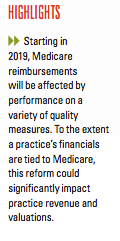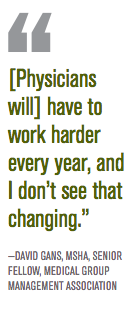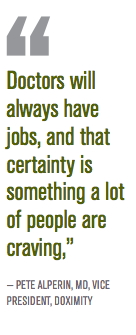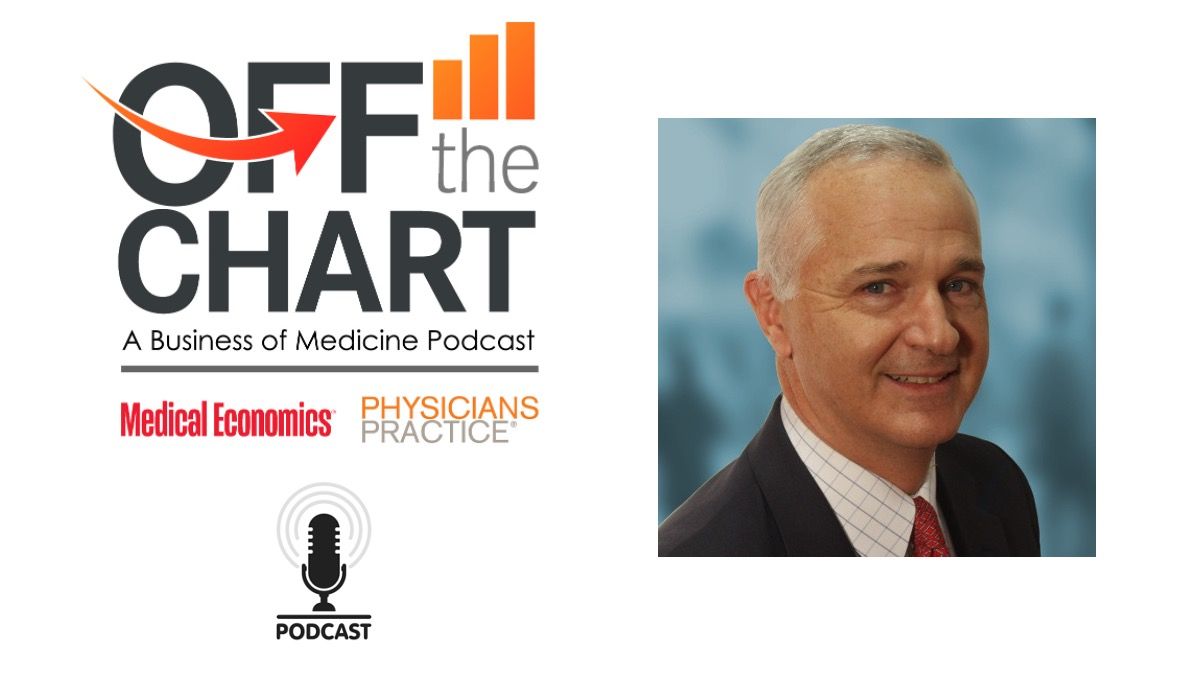Article
Salaries soar for doctors, so why aren't they happy?
Author(s):
Doctors' pay is slowly but steadily improving, Medicare’s sustainable growth rate is a thing of the past and demand for primary care physicians is surging under the Affordable Care Act. So why aren’t doctors happier when it comes to their salaries?

Doctors' pay is slowly but steadily improving, Medicare’s sustainable growth rate is a thing of the past and demand for primary care physicians is surging under the Affordable Care Act. So why aren’t doctors happier when it comes to their salaries?
Lurking behind the pay hikes is a nagging unease about Medicare’s recently-announced reimbursement changes and a sense that medical salaries have a ceiling that’s difficult to break through, while pay in more entrepreneurial and tech fields seems to be surging.
Further reading: 5 strategies to reduce malpractice lawsuit threats
For now, at least, demand seems to be pushing salaries higher, according to several recent physician pay surveys.
More than two-thirds of physicians in Medical Economics’ 87th Annual Physician Report, published in April, said their practice was in the same or better financial shape as the previous year. The survey of employed and private practice doctors, using data collected in 2014, showed an $8,000 gain in average pay for internal medicine physicians, to $211,000.

Median annual compensation for internal medicine physicians in physician-owned groups rose nearly 1% to $255,889 in 2015, according to a study by the Medical Group Management Association (MGMA). In 2014, median pay was $254,211. Factoring in hospital-owned practices drove the median down to $247,319, according to the same report, a nearly 4 percent increase from $238,227 the year before.
A Merritt Hawkins study of job searches for employed physicians, meanwhile, found average salaries for recruited positions jumped by double digits in 2015. The biggest annual gains were in family medicine ($225,000), psychiatry ($250,000) and internal medicine ($237,000).
Over the five years ending in 2015, however, private practice internists earned slightly higher average annual pay increases (3.1%) than their hospital-owned counterparts (2.7%), says David Gans, MSHA, senior fellow, industry affairs for MGMA.
Hospitals tend to recruit primary care doctors as loss leaders, Gans says, meaning they bring in the doctors at an attractive salary without the responsibilities of running a practice. These physicians can then provide referrals for inpatient services.
With their five-year pay increases lagging slightly behind private practices, hospitals may be signaling that there is a limit to how much they are willing to lose. At the same time, signing bonuses are becoming less common, studies show.
In the news: Doctors get new flexibility in Meaningful Use reporting
And that raises questions about where physician pay is heading in the future. Experts say there could be plenty of disruption with value-based pay on the horizon and uncertainty as to whether there is, indeed, a supply shortage of physicians that would drive salaries higher.
Like many doctors, internist Pete Alperin, MD, remembers the long slog through medical school and residency and, finally, the joy of that first attending physician’s paycheck in 1997.

After a decade in private practice, however, the thrill was gone. Today he works hospitalist shifts to keep a hand in medicine, but spends most of his time as vice president of connectivity solutions for Doximity, an online physician network. Earlier, he worked for other tech-based healthcare startups. The chance to substantially boost his pay was a key reason for the switch.
“You make a big jump [in pay after training] and then your salary is in a very narrow range the rest of your life,” he says. After a few years, he says, that can make a career feel stagnant, made worse by watching friends in other professions move further up the pay-and-prestige ladder.
Next: Doubts about future demand, but optimism too
While he says he’s better off financially having made the leap to a start-up company and that it was simply a better fit professionally, Alperin believes medicine still offers the chance to make a great living, arguably with less volatility than the corporate world. “Doctors will always have jobs, and that certainty is something a lot of people are craving,” he says.
Doubts about Future Demand, but Optimism Too
A 2012 research letter published in the Journal of the American Medical Association coauthored by Amitabh Chandra, PhD, found that physician salaries actually declined over the period 2000 to 2010.

In a recent interview with Medical Economics, Chandra said that while an uptick in pay is warranted as primary care physicians are tasked with greater roles in keeping patients healthy, the recent increases could be short-lived as the healthcare industry replaces primary care physicians with nurse practitioners, physician assistants and other non-MDs.
“I don’t really see any systematic forces at play that would drive higher salaries,” he says. “If anything, we see hospitals buying up physician practices and the death of two- and three-person practices,” which means pay incentives used to acquire physicians could be temporary, he says.
Related: Tips for doctors to earn secondary incomes
Even so, he says, he’s encouraged by the long-term opportunities physicians have to retain strong salaries and shape the future of medicine as the industry develops new delivery systems. If they can keep patients’ trust, physicians have the potential to boost their pay through incentives as they help squeeze costs out of the system, he says, taking a bigger share of a shrinking pie.

“The future is good, as long as physicians stay on the side of patient care,” Chandra says. “I would say this is an absolutely great time to be a physician, but they have to own the relationship to patients and not sell that to big hospital systems.” The fact that admission to medical school remains highly competitive, he notes, is a sign that the field remains a magnet for top talent.
Earl Stewart, Jr., MD, who is just beginning his medical career, thinks his financial future as an internist looks bright. He’s completing a three-year payback period at a private practice in Thomaston, Georgia, after receiving annual $20,000 stipends during residency through a State of Georgia physician recruitment program. But he also has taken to heart the discrepancy between salaries in rural and urban America, and plans to stay in his native Georgia even after the payback period.
Had he stayed in New England (he completed an internal medicine residency at Brown University in Providence, Rhode Island), he says, his pay would have been less than what he’s now making, and he’s in a lower-cost state, making that pay go even further.
“I’m starting out as an employed physician, but I have the opportunity to become a partner in the practice down the road,” he says.
Crunching the numbers to find where the physician demand is greatest, Doximity published a map in January showing primary care salaries (internists, ob/gyn and pediatricians) ranged from $305,000 to $330,000 in Arkansas, South Dakota and Iowa, while the District of Columbia, West Virginia and Delaware ranged from $192,000 to $218,000. States with the highest specialist pay were North Dakota, Wyoming and Idaho.
It’s important to note, however, that salary isn’t the main driver for many physicians in choosing specialties, says Keith Boyd, MD, senior associate dean at Rush Medical College in Chicago. “I see students making choices based on lifestyle more than salary,” he says. “For this generation of students, it’s much more important.”
Lifestyle decisions are factoring into Harrison Pidgeon’s career choices. The second-year student at Rush Medical College in Chicago is contemplating emergency medicine for a residency. “Money is not hugely motivating for me,” he says. More important, he says, is the shift-work nature of emergency medicine, with no call.
Next: MACRA's impact
Nate Gross, MD, Doximity’s co-founder, says “we’re seeing a lot of younger doctors interested in new sorts of practice models. They don’t necessarily want to work 120 hours week, and they’re willing to do locum tenens, telemedicine and employed-status with a lower upside in exchange for life flexibility.”
Hedging bets
Michael Iannotti, MD, is hedging his bets on the future by launching different practice models and catering to distinct groups of patients in an effort to shore up his long-term career results. The Lafayette, Colorado, primary care physician is combining an aesthetics practice, a fee-for-service primary care practice, a direct primary care model and concierge medicine.

“Having a blend of income streams is a better way to go than with a single model,” he says. “There’s risk anytime you rely on a single revenue stream. If you are a strictly cash-based practice and the economy tanks, people won’t be able to afford coming to see you and you’ve got a problem.”
In case you missed it: Doctors spending over $32K on health IT
Offering various payment channels, he says, also helps insulate him from getting stuck in the wrong model as healthcare reform continues.
MACRA’s impact
As payment reform works its way through the Medicare system under the Medicare Access and CHIP Reauthorization Act of 2015 (MACRA), reimbursements will be effectively capped for a significant portion of physicians over the next few years, with the Medicare physician fee schedule rising 0.5% annually through 2018.
Starting in 2019, reimbursements will be affected by performance on a variety of quality measures. To the extent that a practice’s financials are tied to the federal program, this could significantly impact practice revenue and valuations, experts say.
But Gans and other experts say the
MACRA changes will eventually create substantial positives and negatives for practices as they move through the new pay systems, which in turn could affect practice valuations used for financing expansion plans or buyouts.
In a recent note to clients, Horne CPAs & Business Advisors warns that reimbursement penalties under the Merit-based Incentive Payment System (MIPS) could cut the fair-market value of practices.
Practices that incur MIPS penalties could see decreased revenue and cash flow, affecting practice bottom lines, warns Chrissy Leggett, CPA, a manager in Horne’s healthcare practice area in Hattiesburg, Mississippi. Of course, those that win MIPS bonuses could see the opposite effect.
In later years of MACRA implementation, Gans says, practices that choose to move toward the advanced alternative payment model (APM) and its 5% incentive bonus payments may see an uptick in physician compensation, but it won’t be dramatic.
“I haven’t seen anything coming out of CMS that substantially revalues primary care on a relative scale” with specialty care, he says. “But primary care doctors are more valued by health systems if they are part of an APM.”
At least in the near term, however, doctors should continue to see pay increases, says Steve Look, executive vice president for The Medicus Firm, a physician recruiter. “There’s no question salaries are going up, particularly in primary care,” he says, as hospitals and other employers snap up more physicians for employment arrangements The challenge now, he says, is reconciling those salaries with the coming productivity measures.
Gans notes that physicians are earning more, “but they are working for it.” Many practices are getting better at running their businesses and setting fees, he says.
That should position them well for when MACRA’s static increases transition to bonuses and penalties. “But they’ll have to work harder every year, and I don’t see that changing,” Gans says.





